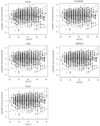Abstract
Objective
To determine the age-related distribution of anti-Müllerian hormone (AMH) in Korean women with regular menstruation who visited fertility center.
Methods
Between May 2010 and April 2011, serum AMH levels on day 2-3 of a spontaneous menstrual cycle were evaluated in 2,879 women of reproductive age ranging from 25 to 45 years old, retrospectively.
Results
The mean age was 34.2 ± 4.3 years. The overall mean AMH value was 3.54 ± 2.66 ng/mL (median, 2.9 ng/mL). Serum AMH level showed an age-dependent distribution and correlated negatively with age. Among multiple regression models, the quadratic model was most appropriated to describe the relationship between AMH and age (logAMH = -1.442 + 0.225 × age-0.004 × age2).
Figures and Tables
 | Fig. 1Age-related basal hormonal levels. (A) Age-related anti-Müllerian hormone (AMH) levels. (B) Age-related basal follicle stimulating hormone (FSH) levels. (C) Age-related basal estradiol (E2) levels. |
 | Fig. 2Distribution of AMH and log(AMH) levels in women with regular menstruation. (A) AMH levels in women with regular menstruation. (B) Log(AMH) levels in women with regular menstruation. AMH, anti-Müllerian hormone. |
 | Fig. 4Residuals from five regression models applied to validation dataset, plotted against age, with nonparametric smoothed estimates and 95% confidence intervals. AMH, anti-Müllerian hormone. |
Table 1
Serum anti-Müllerian hormone (AMH) level (day 2 to 3) distribution (ng/mL) in women presenting to fertility center

References
1. Weenen C, Laven JS, Von Bergh AR, Cranfield M, Groome NP, Visser JA, et al. Anti-Müllerian hormone expression pattern in the human ovary: potential implications for initial and cyclic follicle recruitment. Mol Hum Reprod. 2004. 10:77–83.
2. La Marca A, Sighinolfi G, Radi D, Argento C, Baraldi E, Artenisio AC, et al. Anti-Müllerian hormone (AMH) as a predictive marker in assisted reproductive technology (ART). Hum Reprod Update. 2010. 16:113–130.
3. Seifer DB, MacLaughlin DT, Christian BP, Feng B, Shelden RM. Early follicular serum Müllerian-inhibiting substance levels are associated with ovarian response during assisted reproductive technology cycles. Fertil Steril. 2002. 77:468–471.
4. Fanchin R, Schonäuer LM, Righini C, Guibourdenche J, Frydman R, Taieb J. Serum anti-Müllerian hormone is more strongly related to ovarian follicular status than serum inhibin B, estradiol, FSH and LH on day 3. Hum Reprod. 2003. 18:323–327.
5. Lee JY, Jee BC, Lee JR, Kim CH, Park T, Yeon BR, et al. Age-related distributions of anti-Müllerian hormone level and anti-Müllerian hormone models. Acta Obstet Gynecol Scand. 2012. 91:970–975.
6. Yoo JH, Kim HO, Cha SW, Park CW, Yang KM, Song IO, et al. Age specific serum anti-Müllerian hormone levels in 1,298 Korean women with regular menstruation. Clin Exp Reprod Med. 2011. 38:93–97.
7. Shebl O, Ebner T, Sir A, Schreier-Lechner E, Mayer RB, Tews G, et al. Age-related distribution of basal serum AMH level in women of reproductive age and a presumably healthy cohort. Fertil Steril. 2011. 95:832–834.
8. Almog B, Shehata F, Suissa S, Holzer H, Shalom-Paz E, La Marca A, et al. Age-related normograms of serum antiMüllerian hormone levels in a population of infertile women: a multicenter study. Fertil Steril. 2011. 95:2359–2363.
9. Nelson SM, Messow MC, Wallace AM, Fleming R, McConnachie A. Nomogram for the decline in serum antiMüllerian hormone: a population study of 9,601 infertility patients. Fertil Steril. 2011. 95:736–741.
10. Seifer DB, Baker VL, Leader B. Age-specific serum anti-Müllerian hormone values for 17,120 women presenting to fertility centers within the United States. Fertil Steril. 2011. 95:747–750.
11. Scott RT, Toner JP, Muasher SJ, Oehninger S, Robinson S, Rosenwaks Z. Follicle-stimulating hormone levels on cycle day 3 are predictive of in vitro fertilization outcome. Fertil Steril. 1989. 51:651–654.
12. Levi AJ, Raynault MF, Bergh PA, Drews MR, Miller BT, Scott RT Jr. Reproductive outcome in patients with diminished ovarian reserve. Fertil Steril. 2001. 76:666–669.
13. Toner JP, Philput CB, Jones GS, Muasher SJ. Basal follicle-stimulating hormone level is a better predictor of in vitro fertilization performance than age. Fertil Steril. 1991. 55:784–791.
14. Scott RT Jr, Hofmann GE, Oehninger S, Muasher SJ. Intercycle variability of day 3 follicle-stimulating hormone levels and its effect on stimulation quality in in vitro fertilization. Fertil Steril. 1990. 54:297–302.
15. Martin JS, Nisker JA, Tummon IS, Daniel SA, Auckland JL, Feyles V. Future in vitro fertilization pregnancy potential of women with variably elevated day 3 follicle-stimulating hormone levels. Fertil Steril. 1996. 65:1238–1240.
16. Licciardi FL, Liu HC, Rosenwaks Z. Day 3 estradiol serum concentrations as prognosticators of ovarian stimulation response and pregnancy outcome in patients undergoing in vitro fertilization. Fertil Steril. 1995. 64:991–994.
17. Smotrich DB, Widra EA, Gindoff PR, Levy MJ, Hall JL, Stillman RJ. Prognostic value of day 3 estradiol on in vitro fertilization outcome. Fertil Steril. 1995. 64:1136–1140.
18. Evers JL, Slaats P, Land JA, Dumoulin JC, Dunselman GA. Elevated levels of basal estradiol-17beta predict poor response in patients with normal basal levels of follicle-stimulating hormone undergoing in vitro fertilization. Fertil Steril. 1998. 69:1010–1014.
19. Seifer DB, Golub ET, Lambert-Messerlian G, Benning L, Anastos K, Watts DH, et al. Variations in serum Müllerian inhibiting substance between white, black, and Hispanic women. Fertil Steril. 2009. 92:1674–1678.
20. Freeman EW, Gracia CR, Sammel MD, Lin H, Lim LC, Strauss JF 3rd. Association of anti-Müllerian hormone levels with obesity in late reproductive-age women. Fertil Steril. 2007. 87:101–106.
21. Piouka A, Farmakiotis D, Katsikis I, Macut D, Gerou S, Panidis D. Anti-Müllerian hormone levels reflect severity of PCOS but are negatively influenced by obesity: relationship with increased luteinizing hormone levels. Am J Physiol Endocrinol Metab. 2009. 296:E238–E243.
22. Jayaprakasan K, Campbell B, Hopkisson J, Johnson I, Raine-Fenning N. A prospective, comparative analysis of anti-Müllerian hormone, inhibin-B, and three-dimensional ultrasound determinants of ovarian reserve in the prediction of poor response to controlled ovarian stimulation. Fertil Steril. 2010. 93:855–864.




 PDF
PDF ePub
ePub Citation
Citation Print
Print






 XML Download
XML Download